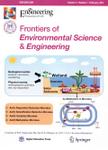Optimizing synthesis conditions of nanoscale zero-valent iron (nZVI) through aqueous reactivity assessment
Optimizing synthesis conditions of nanoscale zero-valent iron (nZVI) through aqueous reactivity assessment作者机构:Department of Civil and Environmental Engineering Texas Tech University Lubbock TX 79409 USA State Key Laboratory for Pollution Control & Resources Reuse Tongji University Shanghai 200092 China
出 版 物:《Frontiers of Environmental Science & Engineering》 (环境科学与工程前沿(英文))
年 卷 期:2015年第9卷第5期
页 面:813-822页
核心收录:
学科分类:081704[工学-应用化学] 07[理学] 08[工学] 0817[工学-化学工程与技术] 0805[工学-材料科学与工程(可授工学、理学学位)] 080502[工学-材料学] 0703[理学-化学] 070301[理学-无机化学]
主 题:iron nanoparticles nanoscale iron particles(nZVI) synthesis characterization Cu(II) reduction nitratereduction
摘 要:Nanoscale iron particles (nZVI) is one of the most important engineered nanomaterials applied to environmental pollution control and abatement. Although a multitude of synthesis approaches have been proposed, a facile method to screen the reactivity of candidate nZVI materials produced using different methods or under varying synthesis conditions has yet been established. In this study, four reaction parameters were adjusted in the preparation of borohydride-reduced nZVI. The reductive properties of the resultant nanoparticles were assayed independently using two model aqueous contaminants, Cu (II) and nitrate. The results confirm that the reductive reactivity of nZVI is most sensitive to the initial concentration of iron precursor, borohydride feed rate, and the loading ratio of borohydride to ferric ion during particle synthesis. Solution mixing speed, in contrast, carries a relative small weight on the reactivity of nZVI. The two probing reactions (i.e., Cu(II) and nitrate reduction) are able to generate consistent and quantitative inference about the mass-normalized surface activity of nZVI. However, the nitrate assay is valid in dilute aqueous solutions only (50 mg.L~ or lower) due to accelerated deactivation of iron surface at elevated nitrate concentra- tions. Additional insights including the structural and chemical makeup of nZVI can be garnered from Cu(II) reduction assessments. The reactivity assays investigated in this study can facilitate screening of candidate materials or optimization of nZVI production parameters, which complement some of the more sophisticated but less chemically specific material characterization methods used in the nZVI research.



